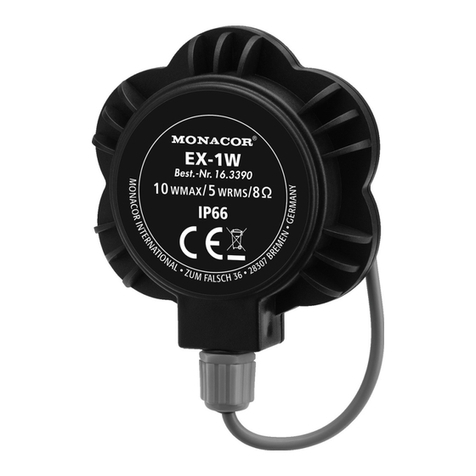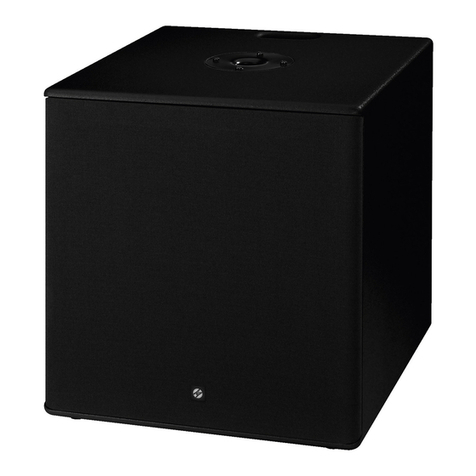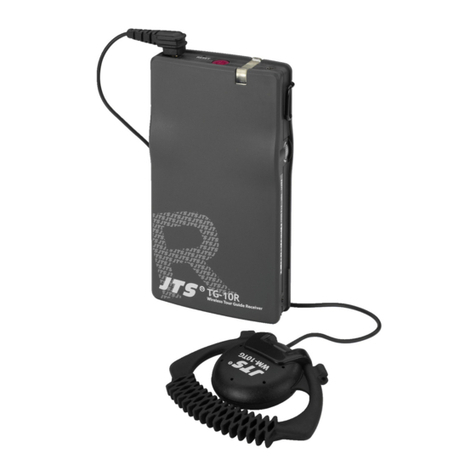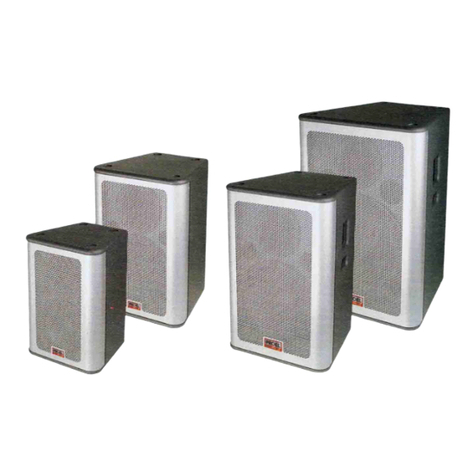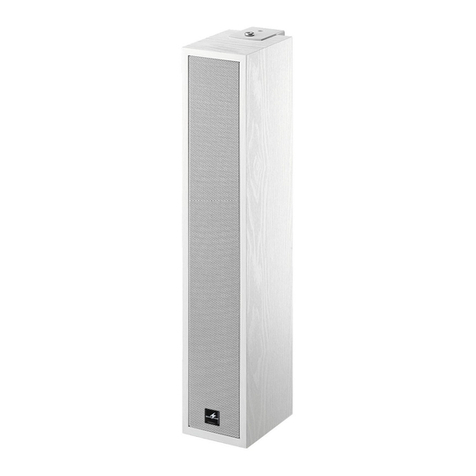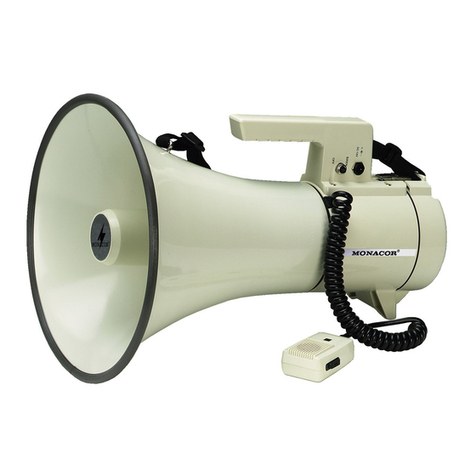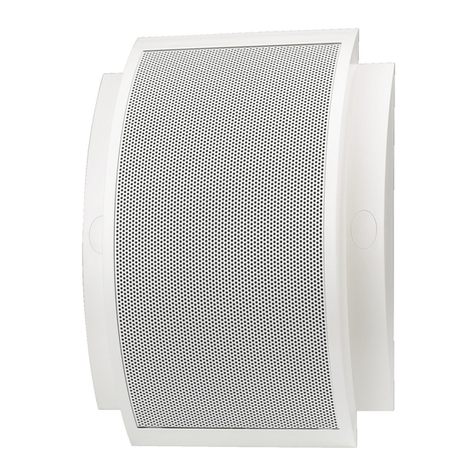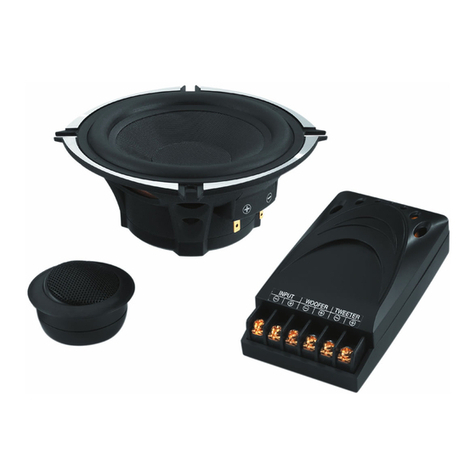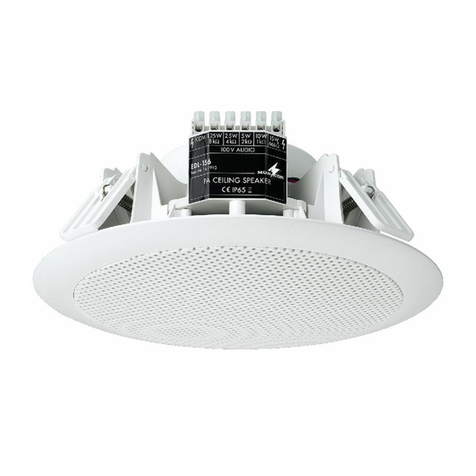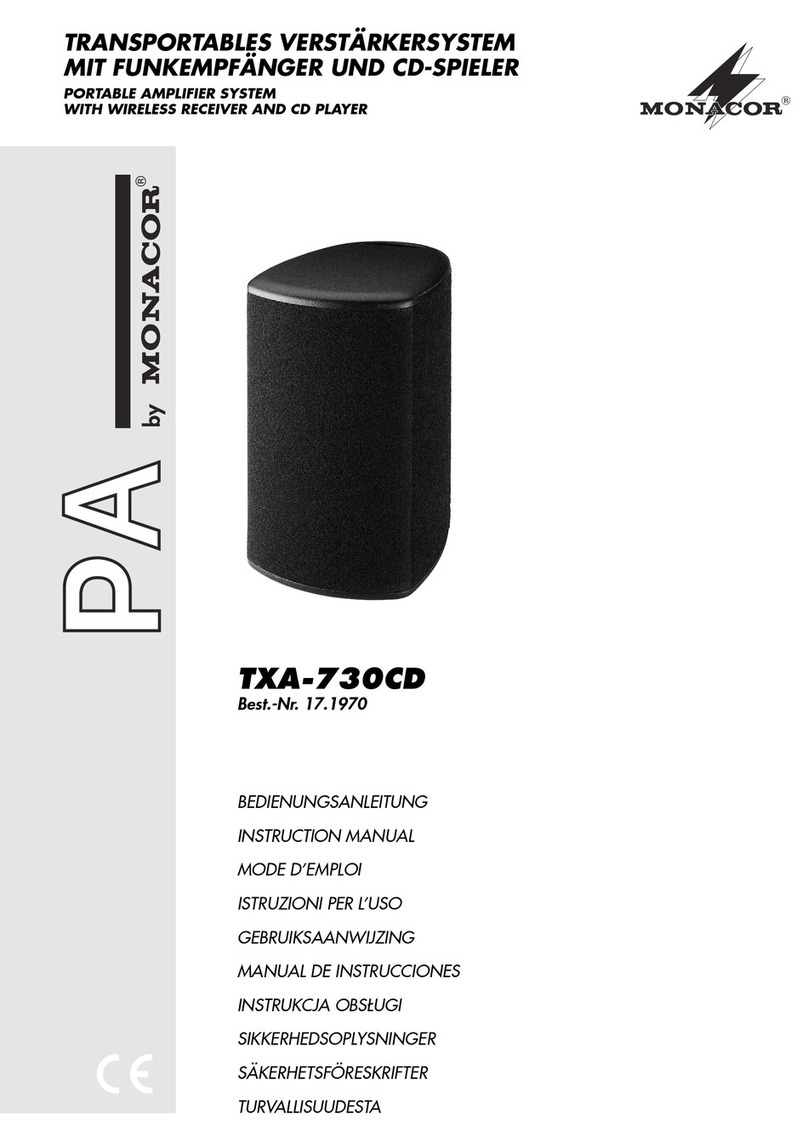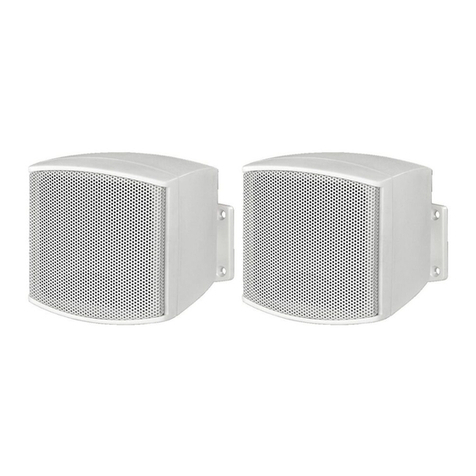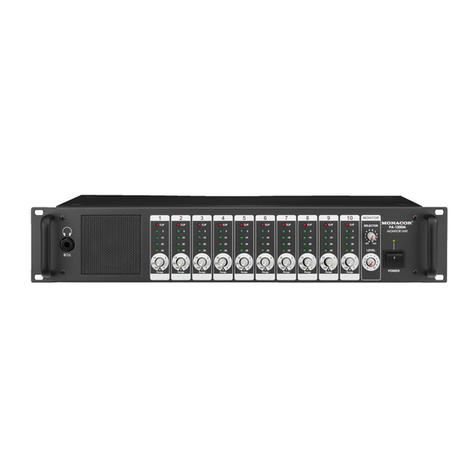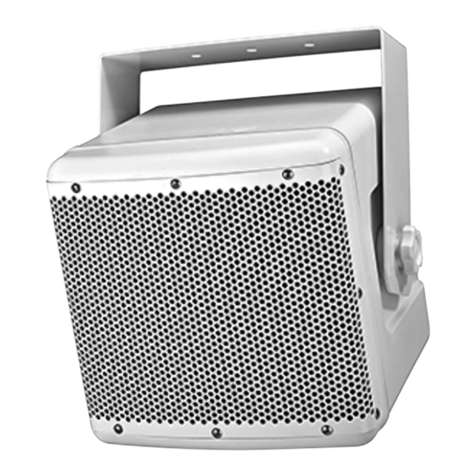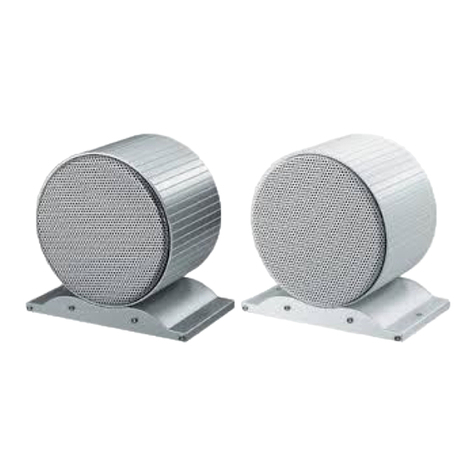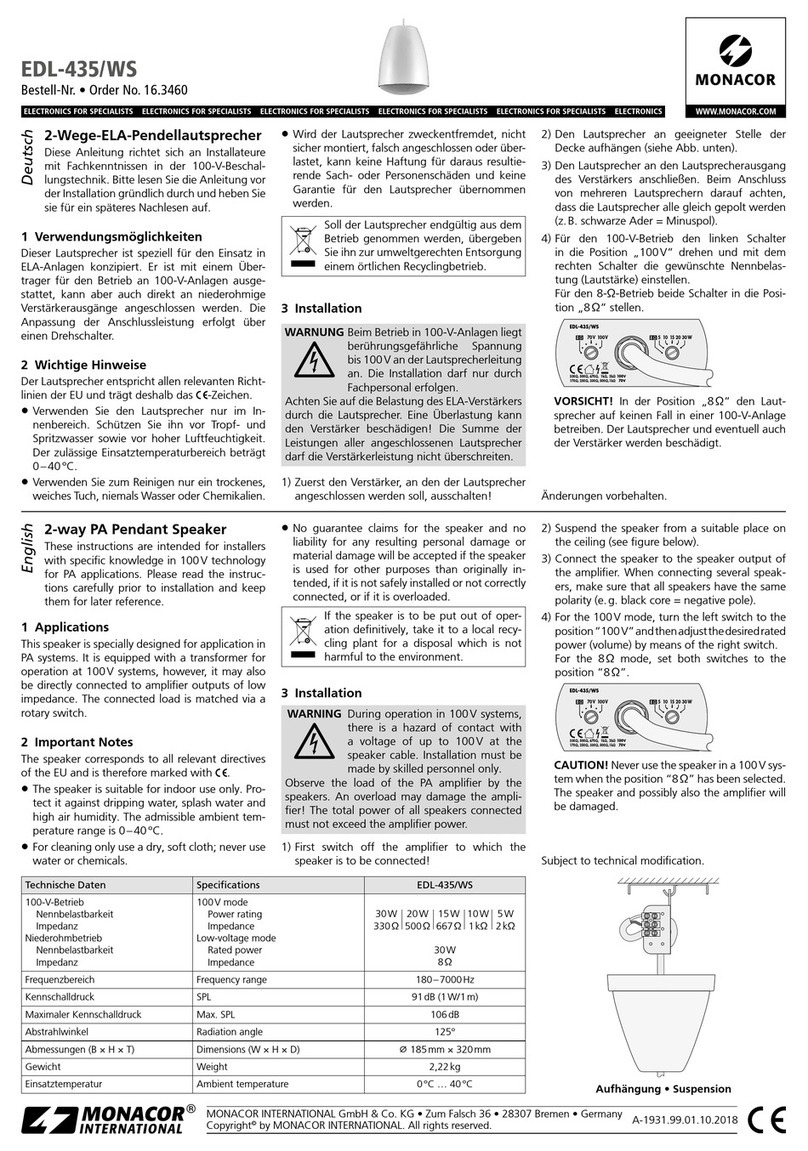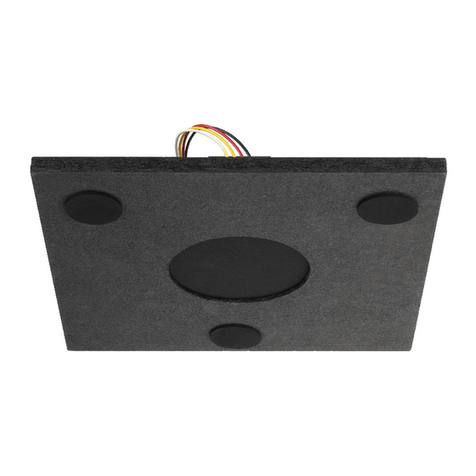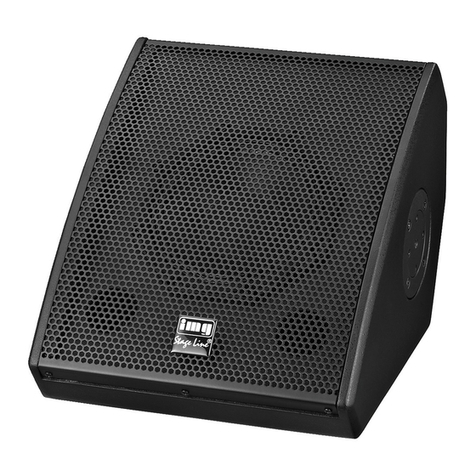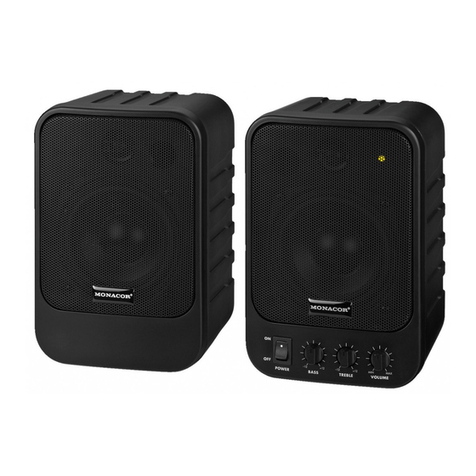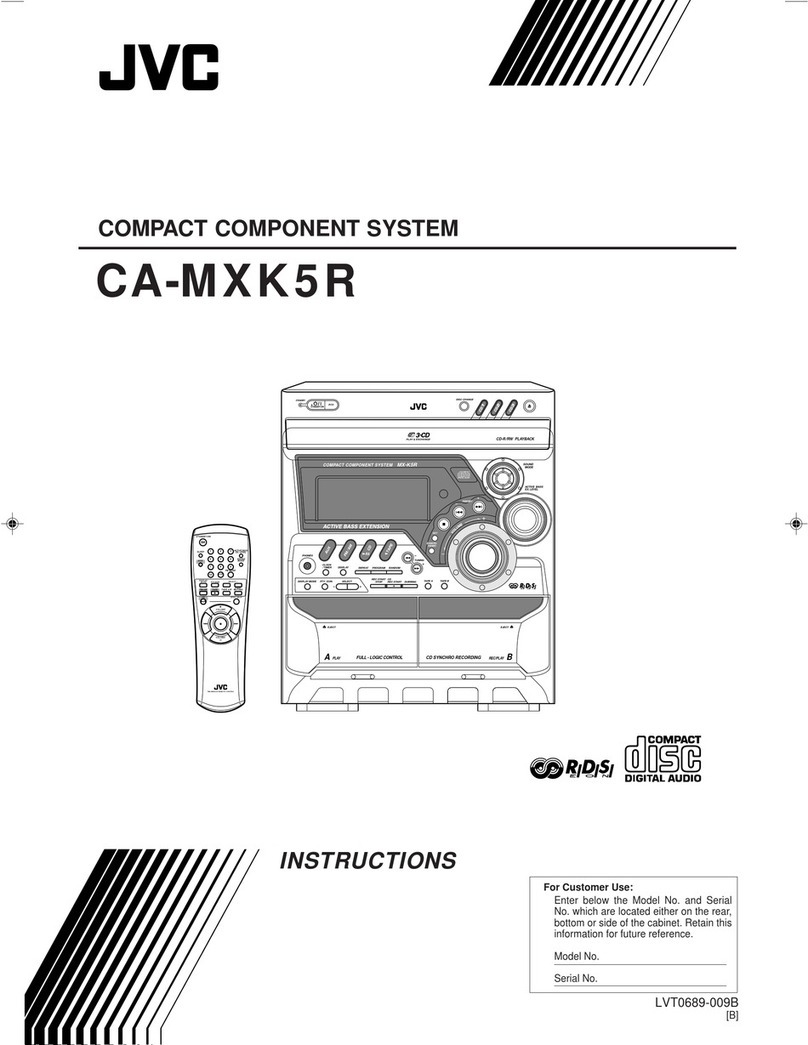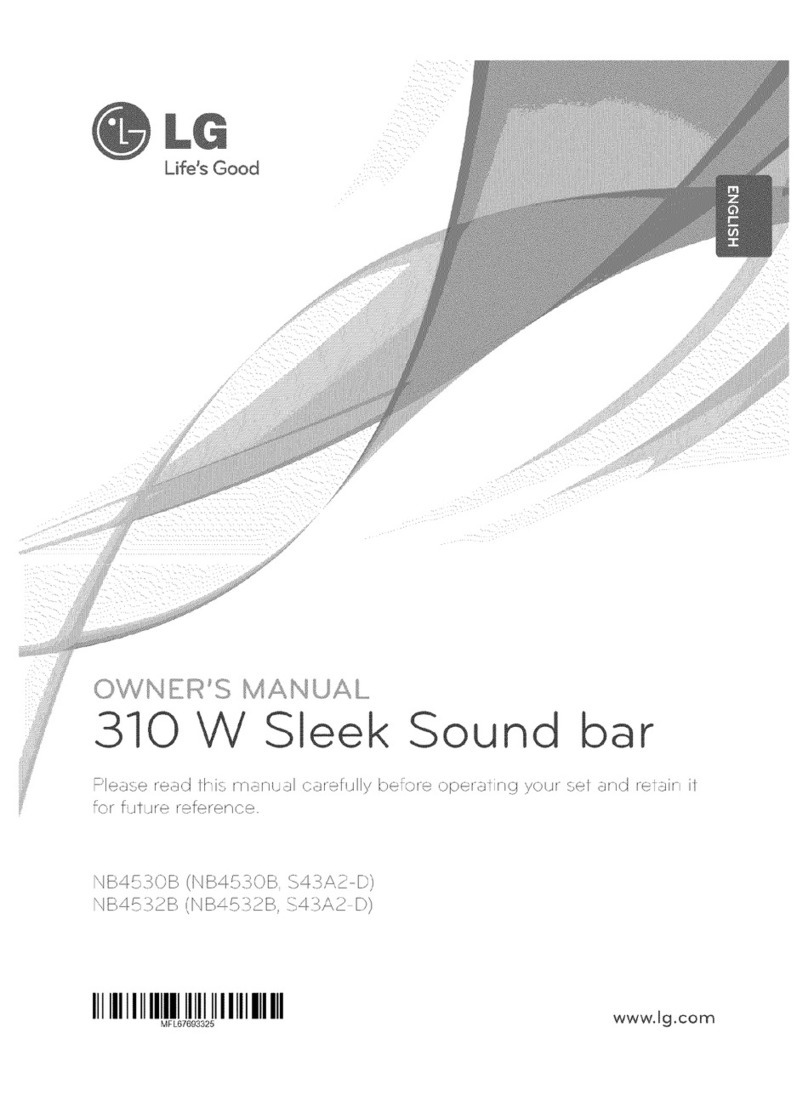Haut-parleur
Public Adress mural
Veuillez lire la présente notice avec attention avant
lʼinstallation et conservez-la pour pouvoir vous y
reporter ultérieurement.
1 Possibilités dʼutilisation
Ce haut-parleur mural est spécialement conçu pour
une utilisation dans des installations de Public Adress
fonctionnant en ligne 100 V. Il est idéal pour une resti-
tution optimale de la parole et de la musique de fond.
Le boîtier métallique solide le protège des dommages
(par exemple jets de ballon).
2 Conseils importants dʼutilisation
Le haut-parleur répond à toutes les directives néces-
saires de lʼUnion européenne et porte donc le symbole
.
GLʼappareil nʼest conçu que pour une utilisation en
intérieur. Protégez-le des éclaboussures, de tout
type de projections dʼeau, dʼune humidité élevée de
lʼair et de la chaleur (température ambiante admissi-
ble 0 – 40 °C).
GPour le nettoyage, utilisez uniquement un chiffon
sec et doux, en aucun cas de produits chimiques ou
dʼeau.
GNous déclinons toute responsabilité en cas de dom-
mages matériels ou corporels résultants si le haut-
parleur est utilisé dans un but autre que celui pour
lequel il a été conçu, sʼil nʼest pas correctement ins-
tallé ou sʼil y a surcharge ; en outre, la garantie
deviendrait caduque.
3 Montage
1) Dévissez les trois vis sur le boîtier.
2) Retirez avec précaution la façade du boîtier de la
face arrière du boîtier. Les deux éléments du boîtier
sont reliés entre eux par les câbles haut-parleurs.
Pour pouvoir retirer la façade, déconnectez les
câbles haut-parleur du haut-parleur.
3) Faites passer les câbles de branchement par lʼar-
rière, au milieu de la face arrière du boîtier, via le
trou dʼentrée du câble. Si les câbles doivent passer
par le haut et non par lʼarrière, ouvrez, sur lʼarête
supérieure de la face arrière du boîtier, un des trous
de découpe pour passage pour les câbles.
4) Fixez la face arrière du boîtier au mur avec le maté-
riel de montage adéquat.
5) Effectuez le branchement électrique (→voir chapi-
tre 4).
6) Reliez les câbles haut-parleur (noir = moins, rouge
= plus) au haut-parleur, replacez la façade et revis-
sez lʼensemble.
4 Branchement
AVERTISSEMENT Pendant le fonctionnement, une
tension de contact dangereuse
jusquʼà 100 V est présente au
câble de branchement.
Seul un personnel qualifié peut
effectuer lʼinstallation.
Lorsque le haut-parleur est définitivement
retiré du service, vous devez le déposer dans
une usine de recyclage adaptée pour contri-
buer à son élimination non polluante.
1) Eteignez lʼintégralité de lʼinstallation Public Adress
avant dʼeffectuer le branchement électrique du haut-
parleur pour que le câble audio 100 V de lʼamplifica-
teur Public Adress ne soit pas porteur de tension !
2) Reliez le haut-parleur au câble audio 100 V de lʼam-
plificateur Public Adress via les bornes “IN
-
” et “IN+”.
3) Pour régler la puissance nominale (volume) pour le
haut-parleur, reliez, sur le transformateur, le câble
rouge au contact dont le repère correspond à la
puissance nominale souhaitée (6 W, 3 W, 1,5 W ou
0,75 W).
4) Via les bornes “OUT
-
“ et OUT+“, on peut relier un
autre haut-parleur Public Adress au câble audio
100 V.
5) Le boîtier peut être relié à la terre via la borne .
Si plusieurs haut-parleurs sont reliés, veillez à ce quʼils
aient tous la même polarité et que lʼamplificateur
Public Adress ne soit pas en surcharge.
5 Caractéristiques techniques
Bande passante : . . . . . 250 – 10000 Hz
Puissance
nominale/Impédance : . 6 WRMS/1,67 kΩ
3W
RMS/3,33 kΩ
1,5 WRMS/6,67 kΩ
0,75 WRMS/13,33 kΩ
Dimensions, poids : . . . .170 × 170 × 63 mm, 1,3 kg
Tout droit de modification réservé.
Faites attention à la charge de lʼamplificateur PA par
les haut-parleurs. Une surcharge peut endommager
lʼamplificateur. La somme des puissances de lʼen-
semble des haut-parleurs reliés ne doit pas dépasser
la puissance de lʼamplificateur.
ESP-80/ WS Best.-Nr. 16.2380
Diffusore PA da parete
Vi preghiamo di leggere attentamente le presenti istru-
zioni prima dellʼinstallazione e di conservarle per un
uso futuro.
1 Possibilità dʼimpiego
Questo diffusore da parete è stato realizzato special-
mente per lʼimpiego in impianti PA che funzionano con
uscita audio 100 V. È adatto in maniera ottimale alla
riproduzione di lingua parlata e di musica di sotto-
fondo. Il robusto contenitore metallico lo protegge dai
danneggiamenti (p. es. da lanci di palloni).
2 Avvertenze importanti per lʼuso
Questʼapparecchio è conforme a tutte le direttive
richieste dellʼUE e pertanto porta la sigla .
GIl diffusore è previsto solo per lʼuso allʼinterno di
locali. Proteggerlo dallʼacqua gocciolante e dagli
spruzzi dʼacqua, da alta umidità dellʼaria e dal calore
(temperatura dʼimpiego ammessa fra 0 e 40 °C).
GPer la pulizia usare solo un panno morbido, asciutto;
non impiegare in nessun caso prodotti chimici o
acqua.
GNel caso dʼuso improprio, dʼinstallazione sbagliata
o di sovraccarico dellʼaltoparlante, non si assume
nessuna responsabilità per eventuali danni conse-
quenziali a persone o a cose e non si assume nes-
suna garanzia per il diffusore.
Se si desidera eliminare il diffusore definiti-
vamente, consegnarlo per lo smaltimento ad
unʼistituzione locale per il riciclaggio.
3 Montaggio
1) Svitare le tre viti sul contenitore.
2) Staccare il frontale delicatamente dal retro del con-
tenitore. Le parti del contenitore sono collegati fra di
loro per mezzo dei cavi per lʼaltoparlante. Per poter
togliere il frontale completamente, sfilare i cavi del-
lʼaltoparlante dallo stesso.
3) Fare passere i cavi di collegamento dal di dietro
attraverso il passacavi nel centro del lato posteriore
del contenitore. Se invece di passare dal di dietro, i
cavi devono passare dallʼalto, occorre creare un
passacavi in uno dei punti previsti per lʼapertura.
4) Fissare il retro del contenitore alla parete per mezzo
di materiali adatti per il montaggio.
5) Effettuare il collegamento elettrico (→Capitolo 4).
6) Collegare nuovamente i cavi dellʼaltoparlante con
lʼaltoparlante (nero = negativo, rosso = positivo),
rimettere il frontale ed avvitarlo.
4 Connessione
AVVERTIMENTO Durante il funzionamento, nel
cavo di collegamento è presente
una tensione fino a 100 V, perico-
losa in caso di contatto.
Lʼinstallazione deve essere ese-
guita solo da personale specializ-
zato.
Tener presente anche la potenza dellʼamplificatore
PA rispetto agli altoparlanti. Un sovraccarico può
danneggiare lʼamplificatore! La somma delle potenze
di tutti gli altoparlanti collegati non deve superare la
potenza dellʼamplificatore.
1) Prima di effettuare la connessione, spegnere com-
pletamente lʼimpianto PA, affinché la linea audio
100 V dallʼamplificatore PA sia esente di tensione!
2) Collegare lʼaltoparlante con la linea audio 100 V dal-
lʼamplificatore PA per mezzo dei morsetti “IN
-
” e
“IN+”.
3) Per impostare la potenza nominale (volume) per
lʼaltoparlante, inserire sul trasformatore il cavetto
rosso sul contatto la cui scritta corrisponde alla
potenza nominale desiderata (6 W, 3 W, 1,5 W o
0,75 W).
4) Per mezzo dei morsetti “OUT
-
” e “OUT+” è possi-
bile collegare un altro diffusore PA con uscita audio
100 V.
5) Attraverso il morsetto , il contenitore può essere
collegato con la terra.
Collegando più diffusori fare attenzione allʼidentica
polarità di tutti gli altoparlanti e di non sovraccaricare
lʼamplificatore PA.
5 Dati tecnici
Banda passante: . . . . . . 250 – 10 000 Hz
Potenza nominale/
Impedenza: . . . . . . . . . . 6 WRMS/1,67 kΩ
3 WRMS/3,33 kΩ
1,5 WRMS/6,67 kΩ
0,75 WRMS/13,33 kΩ
Dimensioni: . . . . . . . . . . 170 × 170 × 63 mm
Peso: . . . . . . . . . . . . . . . 1,3 kg
Con riserva di modifiche tecniche.
®
MONACOR INTERNATIONAL GmbH & Co. KG • Zum Falsch 36 • 28307 Bremen • Germany
Copyright©by MONACOR INTERNATIONAL. All rights reserved. A-0850.99.02.08.2011
®
F B CH
I
